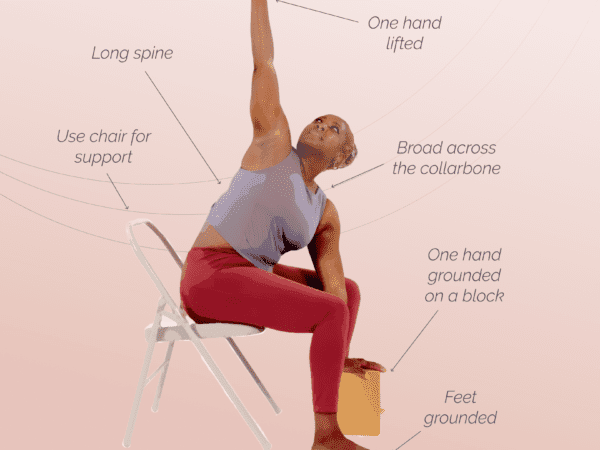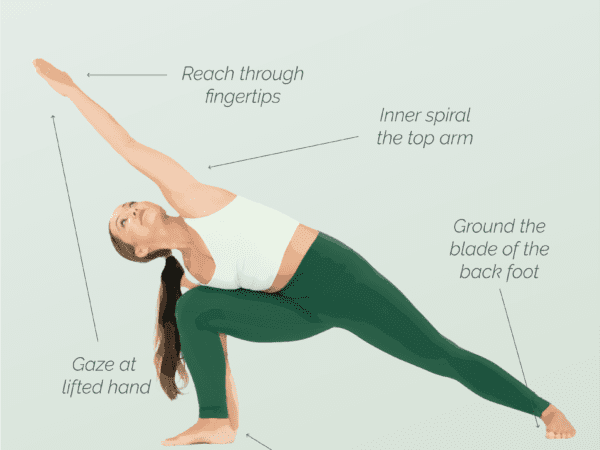Also known as the Four-Limbed Staff Pose or Four Pointed Staff Pose, Chaturanga Dandasana is a pose that is commonly used in your practice. When you first start to practice you might feel like this position is kind of impossible. If you don’t have a lot of upper body strength you might tend to bellyflop to the ground. Chaturanga Dandasana helps you build up strength from whatever level you’re at in the moment. As you practice this pose you’ll develop more strength, bodily intelligence, aliveness, and awareness.
Benefits of Four-Pointed Staff Pose
Four-pointed staff pose, also known as chaturanga dandasana, offers numerous benefits for both the body and mind, particularly strengthening the chest. Here are some key advantages, including muscle activation:
Strengthens Core Muscles: This pose involves significant core engagement, as it strengthens the core muscles, including the abdominals and lower back, promoting better posture and stability.
Enhances Upper Body Strength: By holding your body parallel to the ground in plank pose, you build strength in your shoulders, arms, and chest, as well as develop arm balance skills, which can improve your performance in other yoga poses and daily activities.
Improves Balance and Coordination: Maintaining this pose requires balance and coordination, helping to develop these skills over time.
Boosts Endurance: Holding four-pointed staff pose can increase your endurance and stamina, making it easier to sustain other challenging poses.
Promotes Mental Focus: Concentrating on maintaining proper alignment and balance in this pose can enhance your mental focus and mindfulness.
Supports Joint Health: This pose can help to stabilize and strengthen the joints, particularly the wrists, elbows, and shoulders, reducing the risk of injury.
Enhances Flexibility: Regular practice can improve the flexibility of your muscles and joints, contributing to overall physical agility.
Incorporating four-pointed staff pose into your yoga routine can lead to significant improvements in strength, balance, and mental clarity. Whether you’re a beginner or an experienced yogi, this pose offers valuable benefits that can enhance your overall yoga practice.
Contraindications for Four-Pointed Staff Pose
While four-pointed staff pose (Chaturanga dandasana) offers numerous benefits, it may not be suitable for everyone. Here are some contraindications to consider:
Wrist Injuries: If you have any wrist injuries or conditions such as carpal tunnel syndrome, this pose can exacerbate the issue. Consider modifying the pose or using wrist supports.
Shoulder Problems: Individuals with shoulder injuries or instability should avoid this pose, as it places significant stress on the shoulder joints.
Lower Back Pain: Those experiencing lower back pain or issues should be cautious, as improper alignment can strain the lower back.
Pregnancy: Pregnant women, especially in the later stages, should avoid this pose due to the pressure it places on the abdomen.
Elbow Injuries: If you have any elbow injuries or conditions, this pose can put undue stress on the elbows and should be avoided.
High Blood Pressure: People with high blood pressure should practice this pose with caution, as the effort required can elevate blood pressure levels.
Lack of Core Strength: Beginners or those with weak core muscles should approach this pose gradually to avoid strain and potential injury.
If you have any of these conditions, it’s essential to consult with a healthcare professional or a qualified yoga instructor before attempting any asana. Modifications and alternative poses can often provide similar benefits without the associated risks.
How to do Four-Pointed Staff Pose Step-by-Step Instructions
To understand this posture think about the staff position. Your body represents a staff. From the head down to the feet, your body is knit together and making a straight line. The four points are where your body connects with the floor through the hands and feet.
The easiest way to practice Chaturanga initially is to lie on your stomach. So let’s start out by finding the position of the pose while laying down on the floor.
Laying on your stomach curl your toes under and lift your kneecaps off the floor.
Take your hands to your hips and rotate your tailbone under. Squeeze your glutes slightly and lift the muscles of the lower abdomen by sucking them in.
Firm the muscles of your lower ribs. Place your hands on the floor so they are aligned with your lower ribs.
Draw your shoulder blades down the back but do not pinch them together.
Make sure your shoulders are pointing forward.
Push into the heels so you get a little bit of a bounce and practice doing that in this position to build your familiarity with the pose.
Now push steadily through the heels and push into the ground as though you are going to lift yourself up off the ground in a pushup. You may not be able to get off the ground right now and that’s completely okay. You are building the strength to eventually do so and you are teaching your muscles what to do in the pose.
Come up onto your hands and knees and line up blocks beneath your sternum.
Now get into plank position.
Your hands are under your shoulders. Your core and legs are strong. Your tailbone is tucked.
Now lower yourself down, keeping your elbows in but now tucking the body. Your shoulder blades are down your back and your shoulders are pointed forward.
Lower down so you are on the blocks beneath you. As you lower down wrap the elbows back so you can lower yourself down as slowly as possible. Maintain the integrity of the pose and stay there with the blocks supporting you.
Put your knees down to come out of the pose.
Once you’re confident doing Chadaranga onto blocks do the same thing but move the blocks so you lower slowly all the way to the floor. Don’t let your body flop to the floor. Keep muscles active and lower down slowly.
Now that you’ve tried this method of getting into the pose you can practice with your knees down, so you can come down and up without resting on the floor or on blocks.
Once you’re able to do the pose with the knees down you can try it without putting your knees down. As long as you can maintain the shape we practiced on the floor in the beginning you’re doing the pose correctly. When you lower yourself down don’t lower your shoulders below your elbows. You can always use blocks or bolster to support yourself as you practice and build stretch to do the pose.
Since this is a pose you’ll do again and again it’s good to develop the habit of good alignment early. This way you’ll avoid injury in the future.
When you do the pose remember these points:
- Check the corners of the shoulders. Shoulder blades are back and down.
- Your ribs are drawn in.
- Your tailbone is tucked under. Don’t let the tailbone rise up above the line of the body.
- Your neck is in a neutral position.
- Front body strength, good shoulder position, and good pelvic position are essential.
Find a way to work the pose in a way that is intelligent and safe for your body.
Now that we’ve walked through how to practice Chaturanga Dandasana watch the detailed video by Kino below for more detail.
Other Tips to Keep in Mind While Doing Four-Pointed Staff Pose
Practicing four-pointed staff pose (chaturanga dandasana) effectively requires attention to detail and proper technique. Here are some tips to help you get the most out of this pose:
Engage Your Core: Keep your abdominal muscles engaged to support your lower back and maintain a straight line from your head to your heels.
Align Your Shoulders: Ensure that your shoulders are directly above your wrists and not dipping below your elbows. This alignment is essential for both chaturanga dandasana and upward facing dog, helping to prevent shoulder strain.
Keep Elbows Close: Maintain your elbows close to your ribcage as you lower your body. This helps to engage your triceps and protect your shoulder joints.
Distribute Weight Evenly: Press evenly through your palms and fingers to distribute your weight and reduce pressure on your wrists.
Maintain a Neutral Spine: Avoid sagging your hips or arching your back. Keep your spine neutral to prevent lower back strain.
Breathe Steadily: Focus on maintaining a steady breath throughout the pose. This helps to keep your muscles oxygenated and reduces tension.
Use Props if Needed: If you’re struggling with the full pose, consider using props like yoga blocks under your shoulders or practicing with your knees on the ground.
Warm Up Properly: Ensure that your body is adequately warmed up before attempting this pose. Incorporate poses that open the shoulders, wrists, and core.
Listen to Your Body: Pay attention to any signs of discomfort or pain. If you experience any, come out of the pose and rest.
Practice Regularly: Consistent practice will help you build the strength and endurance needed to hold the pose with proper form.
By keeping these tips in mind, you can safely and effectively practice four-pointed staff pose, enhancing your overall yoga experience.
Are you looking for more guidance on your yoga journey? Sign up for Omstars to get access to thousands of yoga classes in the comfort of your own home. Click here to start your subscription.









